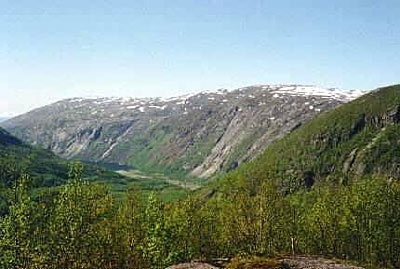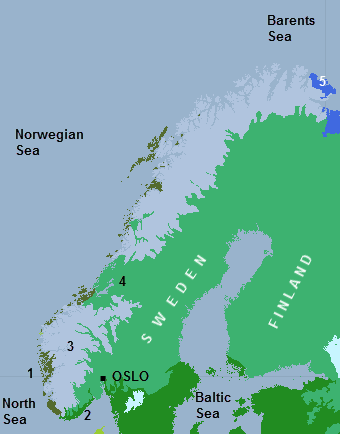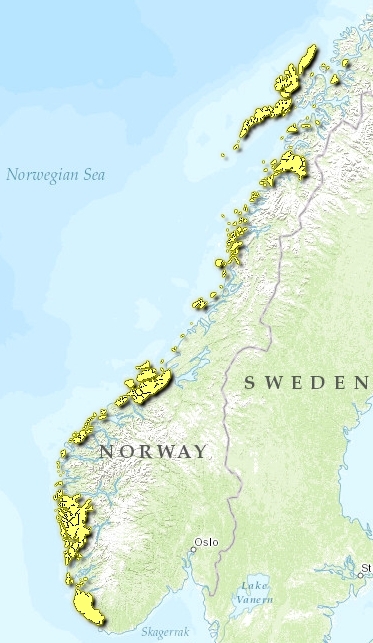Ecoregions of Norway
|
There are several distinctecoregions of Norway which as shown in the map to the right and numbered as follows:
|
Contents
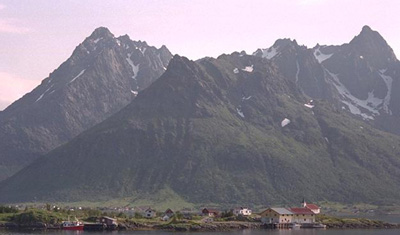 Scandinavian coastal conifer forests Lofoten, Norway Photograph by Stefan Schlesinger In phytogeographic parlance, this ecoregion is part of the Atlantic European province of the Circumboreal Region in the Boreal Kingdom. The North Atlantic moist mixed forests span a considerable distance stretching from the south of Ireland through western Scotland, the far north of Scotland and includes a tiny patch on the southwestern coast of Norway.
Scandinavian coastal conifer forests Lofoten, Norway Photograph by Stefan Schlesinger In phytogeographic parlance, this ecoregion is part of the Atlantic European province of the Circumboreal Region in the Boreal Kingdom. The North Atlantic moist mixed forests span a considerable distance stretching from the south of Ireland through western Scotland, the far north of Scotland and includes a tiny patch on the southwestern coast of Norway.
There are 211 recorded native vertebrate species in the North Atlantic moist mixed forests, according the World Wildlife Fund; however, a full accounting of migratory bird species brings this number considerably higher. There is no endemism among the vertebrates of this ecoregion
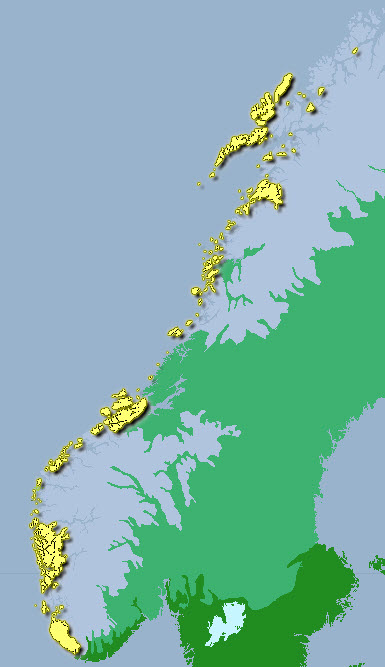 Source: WWF Source: WWF
|
Sarmatic mixed forests
Sarmatic mixed forests comprise an ecoregion distributed over a sizable portion of northern Europe and the Ural area of Russia; more specifically this forest type is found particularly in Scandinavia, the Baltics and the Ural area of Russia. Typically, Sarmatic mixed forests comprise a transition into boreal taiga at their northern limit and mixed broadleaf forests at their southern limit. In Norway, sarmatic mixed forests cover only the southern tip of of the country,
The sarmatic mixed forests are comprised of a mixed conifer broadleaf plant association dominated by Norway Spruce (Picea abies) and Scots Pine (pinus sylvestris) with some broadleaf admixture, especially oak species such as Quercus robur in the north.
Sarmatic mixed forests comprise a transition into boreal taiga at their northern limit and mixed broadleaf forests at their southern limit. The sarmatic mixed forests are comprised of a mixed conifer broadleaf plant association dominated by Norway Spruce (Picea abies) and Scots Pine (pinus sylvestris) with some broadleaf admixture, especially oak species such as Quercus robur in the north.
In addition to the canopy, there are numerous shrubs, wildflowers, grasses and mosses that inhabit the mid-tier and forest floor. Common low-growing shrubs include Bilberry (Vaccinium myrtillus) and Heather (Calluna vulgaris). Example wildflowers or forbs seen in the forest understory include Common Spotted Orchid (Dactylorhiza fuchsii), Red Campion (Silene dioica), White Campion (Silene latifolia ssp. alba), Sand Catchfly (Silene conica), Field Scabious (Knautia arvensis) and Marsh Helleborine (Epipactis palustris). In some fens within forest clearings the Marsh thistle (Cirsium palustre) is found.
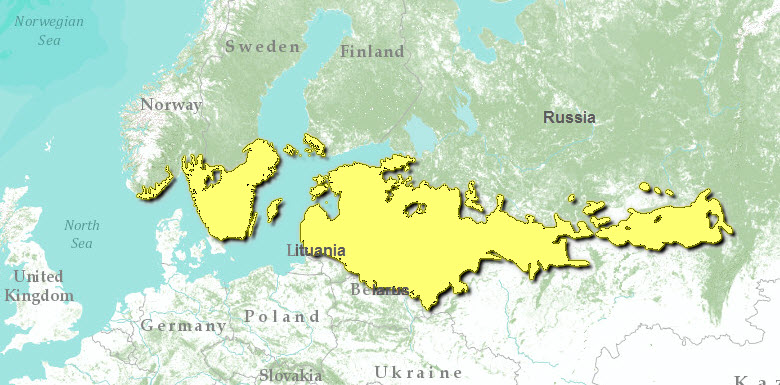 Sarmatic mixed forests stretch from southern Norway to the Ural Mountains. Source: World Wildlife Fund
Sarmatic mixed forests stretch from southern Norway to the Ural Mountains. Source: World Wildlife Fund
Widespread ferns seen on forest floors include Western Brackenfern (Pteridium aquilinum) and Mountain Bladderfern (Cystopteris montana). Common mosses found in the more mesic soils are Broom Forkmoss (Dicranum scoparium), Stairstep Moss (Hylocomium splendens), Red-stemmed Feathermoss (Pleurozium schreberi), Ostrich Plume (Ptilium crista-castrensis) and Common Hair Moss (Polytrichum commune).
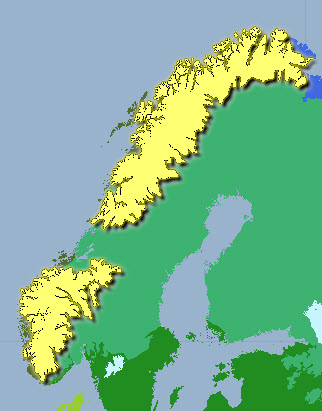 Source: WWF The ecoregion generally follows the Scandinavian Mountains, and the ecoregion as a whole continues into Sweden and Finland. Some of the largest glaciers on the European mainland are located within the Scandinavian montane birch forests and grasslands ecoregion, as well as the highest peaks and the largest mountain plateau in northern Europe. The mountain chain itself creates a rainshadow. This stark ecoregion has extensive sparsely vegetated high alpine tundra areas, dominated by bare rock, skrees, snowfields and glaciers; other areas consist of low alpine tundra covered by Dwarf Birch (Betula nana) admixed with willow of up to one metre in height; this low tundra has patches of grassland, bogs and lakes.
Source: WWF The ecoregion generally follows the Scandinavian Mountains, and the ecoregion as a whole continues into Sweden and Finland. Some of the largest glaciers on the European mainland are located within the Scandinavian montane birch forests and grasslands ecoregion, as well as the highest peaks and the largest mountain plateau in northern Europe. The mountain chain itself creates a rainshadow. This stark ecoregion has extensive sparsely vegetated high alpine tundra areas, dominated by bare rock, skrees, snowfields and glaciers; other areas consist of low alpine tundra covered by Dwarf Birch (Betula nana) admixed with willow of up to one metre in height; this low tundra has patches of grassland, bogs and lakes.
The balance of this ecoregion consists of a landscape similar to the adjacent montane birch zone with two to five metre high mountain downy birch (Betula pubescens) stands estending above the conifer treeline; some stunted Norway spruce and Scots pine are also noted here, and numerous bogs and lakes are present. This part is regarded as part of the North Boreal vegetation zone In the lower elevations, the forests being closed-canopy and generally relate to the Scandinavian and Russian taiga ecoregion, This entire ecoregion is designated as PA 1110,
This ecoregion spreads across a wide expanse of landscape in Scandinavia and northern Russia within the boreal forests/taiga zone. It consists of coniferous forests dominated by Scots Pine in the drier locales), frequently with an understory of Common Juniper (Juniperus communis) and Norway Spruce, along with a significant admixture of White Birch (Betula pubescens) and Silver Birch (Betula pendula). Scandinavian and Russian taiga covers more land area than any other of Sweden's ecoregions, and is designated as ecoregion PA0608.
This ecoregion covers a large percentage of the European continent, with tundra at the north and temperate mixed forests to the south. Only a limited number of coniferous tree species, including pine and juniper, and a few broadleaf trees, including birches and willows, thrive within these taiga forests, with species diversity increasing in the south with maple, linden, ash and oak trees. Characteristic herbaceous plants include sedge, stiff club moss, May lily, twinflower, heart-leaved tway blade, shinleaf, lesser rattlesnake plantain and ground pine. The ecoregion to the north of the Scandinavian and Russian taiga is the Scandinavian montane birch forests and grasslands.
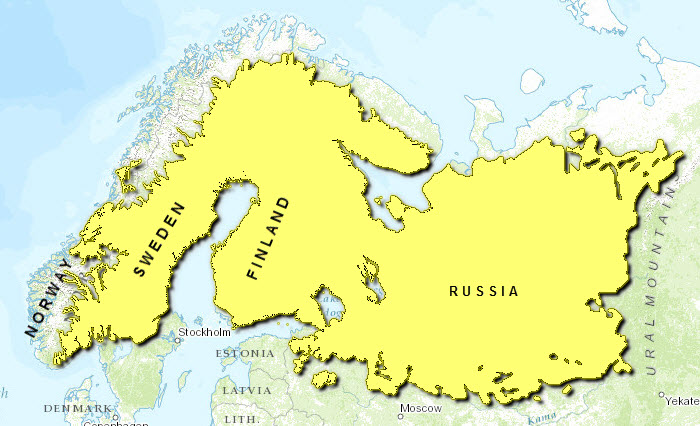 Scandinavian and Russian taiga map. Source: WWF
Scandinavian and Russian taiga map. Source: WWF
Kola Peninsula tundra
The Kola Peninsula tundra exhibits a cold and windy climate, with permafrost limiting the occurrence of trees, producing an environment dominated by grasses, hardy forbs, and shrubs including dwarf birch and cloudberry. In these northern [[coastal] areas], stony and shrub lichens are abundant.
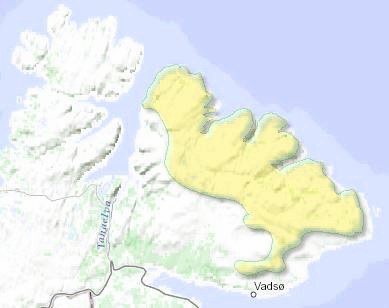 The Kola Peninsula tundra boundary on the Varanga Peninsula of Norway. Source: WWF While the majority of the Kola Peninsula tundra is situated north of the Arctic Circle, the climate is milder than continental zones, owing to the large number of lakes, rivers, and other bodies of water surrounding the peninsula as well as the moderating effect of the Barents Sea that lies along the Norwegian coastline of the Kola Peninsula tundra. Within this ecoregion mountain ranges are interspersed with abundant wetlands.
The Kola Peninsula tundra boundary on the Varanga Peninsula of Norway. Source: WWF While the majority of the Kola Peninsula tundra is situated north of the Arctic Circle, the climate is milder than continental zones, owing to the large number of lakes, rivers, and other bodies of water surrounding the peninsula as well as the moderating effect of the Barents Sea that lies along the Norwegian coastline of the Kola Peninsula tundra. Within this ecoregion mountain ranges are interspersed with abundant wetlands.
Calcareous bedrock and soil along the north of the Varanga Peninsula supports vegetative pockets containing rare species such as the Svalbard Poppy (Papaver dahlianum), the field fleawort, Svalbard snow cinquefoil, and the Tundra Sandwort (Arenaria pseudofrigida).
Context
Ecoregions are areas that: [1] share a large percentage of their species and ecological dynamics; [2] share similar environmental conditions; and, [3] interact ecologically in ways that are critical for their loninclug-term persistence. Scientists at the World Wildlife Fund have established a classification system that divides the world in 867 terrestrial ecoregions, 426 freshwater ecoregions and 229 marine ecoregions that reflect the distribution of a broad range of fauna and flora across the entire Earth.
References
- U.G.Bolub Bohn and C. Hettwer. 2000. Reduced general map of the natural vegetation of Europe. 1:10,000,000. Bonn-Bad Godesberg, Bonn.
- C.Michael Hogan. 2009. Marsh Thistle: Cirsium palustre. GlobalTwitcher.com, ed. N.Strömberg.
- Davis, S. D., V. H. Heywood, and A. C. Hamilton. 1994. Centres of Plant Diversity. Vol. 1: Europe, Africa, Southwest Asia and Middle East. D.C.: WWF and IUCN.
- Digital Map of European Ecological Regions (DMEER), Version 2000/05
- EU DG-ENV 2000. The Directorate General on Environment of the European Union, coordinating the Natura 2000 network (Birds and Habitats Directive).
- Gasc J.P., A. Cabela, J. Crnobrnja-Isailovic, D. Dolmen, K. Grossenbacher, P. Haffner, J. Lescure, H. Martens, J.P. Martinez Rica, H. Maurin, M.E. Oliveira, T.S. Sofianidou, M. Veith, and A. Zuiderwijk, editors. 1997. Atlas of Amphibians and Reptiles in Europe. Societas Europaea Herpetologica & Muséum National d'Histoire Naturelle (IEGB/SPN), Paris, 496pp.
- Heath, M. F., and M. I. Evans, editors. 2000. Important Bird Areas in Europe: Priority sites for conservation. 2 vols. Cambridge, UK: BirdLife International.
- H.Sjors. 1999. Swedish plant geography: The background: Geology, climate and zonation. Acta Phytogeogr. Suec. Uppsala: Opulus press, 84:5-14.
- World Wildlife Fund. 2001. Kola Peninsula tundra.
